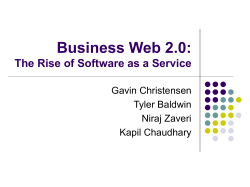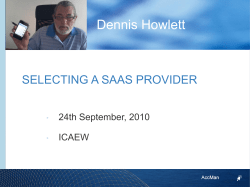
The Ultimate Startup Guide by
The Ultimate Startup Guide by Part 2: The Game-Changing Trends in SaaS May 2015 Prepared by Meagan Crawford, Internal Economist at PeoplePerHour The Game-Changing Trends in SaaS SaaS, or Software as a Service, is radically transforming conventional software tools for micro/SMEs by diminishing transaction costs, increasing market flexibility and providing cost effective outsourcing solutions to IT. Unlike any other time in history, micro/SMEs have a level playing field with large enterprise and Fortune 500 companies through early adoption of a myriad of SaaS solutions, which are enabling massive efficiency gains in areas such as: ERP, CRM, BI & HR solutions to name a few. Unlike conventional software models that command large upfront costs in addition to an annual maintenance fee, SaaS is based on a subscription model and is typically a fraction of a percent of the perpetual model. For investors the next generation SaaS is commanding 5X compared to conventional software companies that observed 1.5X, the market potential for SaaS platforms is enormous and only just beginning to be tapped into. What is SaaS? SaaS, or Software as a Service, describes any cloud service where consumers are able to access software applications over the internet. The applications are hosted in “the cloud” and can be used for a wide range of tasks for both individuals and organisations. Google, Twitter, Facebook and Flickr are all examples of SaaS, with users able to access the services via any internet enabled device. –Interoute The Key Benefits of SaaS: Lower Costs: Flexibility and Ease of Deployment: Standardized solutions: On-Demand Mobile Workforce: SaaS applications level the playing field by providing micro/SMEs tools that had been financially inaccessible up until recently. The SaaS ecosystem is built on predictable monthly license fees (subscription model), and usage based pricing models. Improved management of key business areas: micro/SMEs who have lean, undefined procedures have greater optionality through standardized industry verticals i.e. accounting, sales tracking and invoicing leading to greater operational management. The on-demand SaaS model enables micro/SMEs the flexibility to scale and deploy one business application at a time, while testing the applicability to the business case, and the added benefit of service termination with zero switching costs. The rise in mobile supported SaaS platforms such as CRM enables micro/SMEs to input and access sales data on-the-go, encouraging users to stay remotely connected, increasing productivity outputs. Created on Supertasker PAGE 1 A breakdown of SaaS categories used by PeoplePerHour users The average number of platforms used by PeoplePerHour users Average SaaS platform spend by PeoplePerHour users 27% 2 35.9% £0 54.0% CRM 26.2% 3 11.3% £1-25 14.9% Emailing 19.8% 4 8.9% £50-100 8.9% 4.4% 5 7.3% £100-250 4.0% 13.3% 6 2.0% £250-500 2.4% 9.3% 7 2.0% £500-750 3.6% 8 1.6% £750-1000 1.6% 10 or more 6.1% Marketing Data Protection Project Management Office Suites Human Capital Management Application Complexity WAVES OF SAAS PROGRESSION: On-promise enterprise apps e.g. CRM, ERP Batch & transaction processing SaaS enterprise apps CRM Batch & transaction processing Mainframe Computing DARK AGES ASP hosted enterprise apps Financial Functionality Personal Computer Network Enterprise Websites 1984 2001 Rich Internet Applications 2008 Evolutionary Timeline Global SaaS software revenues are forecasted to reach $106B in 2016, increasing 21% over projected 2015 spending levels at 30% CAGR from 2013-2018 vs. 5% growth for overall enterprise IT. –Goldman Sachs, 2014 Created on Supertasker PAGE 2 High-Growth SaaS Categories: IT Management Applications: 1 IT is increasingly recognizing that cloud solutions can save money and allow workers to focus on what is important to them in areas of core competency, business value, and differentiation. 2 ePurchasing/eProcurement, have greatly shifted over to SaaS in new product categories like services procurement, automated spend analysis, supplier network services, and supplier risk and performance management. ERP & Supply Chain: CRM & Productivity Applications: 3 Desktop and collaboration applications are well-suited for SaaS. Their broad user base of employees, customers, and partners will make accessibility a must. Some CRM attributes that hinder SaaS adoption include a large amount of data, high security, and varied maturity of product. 4 Business Intelligence: 5 6 BI solutions are moving rapidly towards full SaaS deployment HR Software: the user-friendliness and accessibility of SaaS allows for easier collaboration across all levels and departments, eLearning is a rapidly scaling category. Platform & Middleware Solutions: Performance and degree of customization are limiting rapid scaling however, governance, risk and compliance, application development, and storage have signs of slight movement toward SaaS SaaS Most Highly Deployed Global Cloud Service by 2018 PaaS (21% CAGR) 24% CAGR laaS (13% CAGR) 180 2013-2014 SaaS (33% CAGR) 160 13% 140 120 13% 100 80 60 40 20 0 15% 59% 44% 41% 2013 2014 2015 2016 2017 2018 Source: Cisco Globa Cloud, Index, 2013-2018 Created on Supertasker PAGE 3 The Game-Changers of SaaS Zenefits is a free, cloud HR platform that completely automates the admin work behind workers. Employers connect their payroll, health insurance and other HR systems (or set up new ones) in seconds so they can manage it all online, in one beautiful dashboard. That’s when the magic happens: Zenefits automates 95% of the HR administration work so what used to take weeks—from payroll updates to employee on-boarding—now takes minutes. Zenefits currently serves more than 10,000 small-and medium-sized businesses in 47 states, across nearly every industry. Zenefits was co-founded by Parker Conrad and Laks Srini. • Zenefits has signed up more than 10,000 companies across 48 states, serving over 100,000 employees. • Zenefits has an increasingly diverse customer base: In 2013, over 90 percent of customers were from California and over 80 percent were technology companies. Today, more than half of Zenefits’ business is outside California and over half is outside the tech sector. • Zenefits closed more new business in just one month -- March 2015 -- than it did in the first 15 months of the company's life. “There are millions of small businesses in the country that have been wasting countless hours every year juggling multiple HR systems and outdated technology. We are not just eliminating the paperwork; we are eliminating the actual work – making it easier for small businesses to manage and grow. With 5 million small businesses in the US, the market opportunity is huge, and we are moving quickly to go after it.” Parker Conrad, Founder & CEO Zenefits Created on Supertasker PAGE 4 Intercom is a customer communication platform, one place for an entire business to see and talk to customers– inside their product, on their website, or by email. Intercom is integrated with live product data, so messages can be triggered by customer behavior. Using a single integrated platform for every customer interaction gives businesses a more complete view of each customer, allowing for more personalized and contextual communications. • Founded in 2011 • $31M raised • 4k+ paying customers • 100+ employees • 1/3 of active users log in every work day • Revenue grew 5x in 2014 Vend became the world’s first-ever cloud-based POS system for retail, and has continued to lead the wave of second-generation SaaS companies in the years since. Vend is on the same growth trajectory as the world’s most successful first generation cloud companies – like Netsuite, Zendesk, and Salesforce. • Vend is now the most global SaaS company in the world with revenue spread equally between key markets. No other company has this, which makes Vend very unique in the SaaS and POS space. • Vend’s technology has been particularly suited to SMEs. It is inexpensive, well-designed, easy to use and implement, and allows small business owners to do it all – taking sales, tracking inventory, and running their entire business from a mobile device so they are no longer chained to their store, or their clunky cash-register. • Vend has been in hyper-growth mode since it was founded in 2010, increasing its ARR by 100% each year. We now have seven offices and over 220 employees worldwide – and expect this employment figure to double over the next year. Vend is on track to continue on a high-growth trajectory for the next few years (and beyond), through increased funding and investment, a customer base that has risen an average of 240% each year for the past three years “As more retailers move their business to the cloud and take their brick & mortar stores online, we will see increased demand for solutions that provide a one-stop shop for businesses in a way that is flexible and can be tailored exactly to their needs. That could be either a platform containing numerous capabilities and plug-and-play options, or an ecosystem of add-ons that are easily integrated with each other. Companies that can provide SMEs with the ability to build their own unique enterprise systems, in a cost-effective and simple way, will be the ones who are most sought-after.” -Vend Created on Supertasker PAGE 5 Intercom 2014 Intercom 2014 Created on Supertasker PAGE 6 A special thanks to our contributors Zenefits Intercom.io Vend In addition to a special thanks to Nat Burgess of Corum Group Created on Supertasker PAGE 7 For Press Inquiries please contact: Head of PR Aylish Jarvie aylish@peopleperhour.com Signup to SuperTasker to receive $50 off your first task! PROMOTION CODE: SUPERTASKERUK Created on Supertasker
© Copyright 2025









